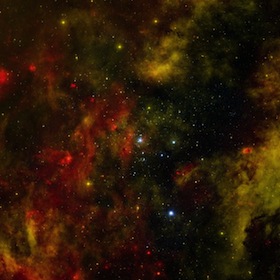Astrobiology consortium supported for additional five years
With the help of a new grant from NASA, University of Wisconsin–Madison researchers are guiding the search for signs of life on distant planets — while keeping their feet firmly planted on Earth.
The Wisconsin Astrobiology Research Consortium, led by geoscience professor Clark Johnson and including partners from across the U.S. and world, specializes in defining and identifying “biosignatures,” fingerprints of ancient life that are preserved in the geological record.

Renewed funding of $9 million over five years will fund the work of the Wisconsin Astrobiology Research Consortium.
Photo: NASA
Started in 2007, the WARC has focused on developing new tools and methods for detecting evidence of past life through its lingering effects on the geologic record, looking for the elements of life now locked up in minerals that persist in ancient rocks. This fall they received a second five-year grant, for $9 million, from NASA to continue as a member of the NASA Astrobiology Institute.
As the Curiosity rover probes the Martian surface for signs of water and other features, the Wisconsin consortium is preparing for the next steps — identifying characteristics of potentially habitable environments and devising approaches and instruments to search for evidence of past or present life in those environments.
Developing such approaches on Earth is critical for future success elsewhere. For example, many organic molecules can become so tightly bound to clay minerals in the soil that regular tools will not detect them even if present. “We already know it’s a problem from our work in terrestrial environments,” says Johnson. Without working out a solution on Earth, “the next missions to Mars, which would be life-detection missions, are in danger of not being successful.”
The research is also probing the evolution of life on Earth. The biosignatures they seek are remnants of microbes, Johnson says, which dominated the Earth for billions of years and are the most likely life forms to find on Mars and other planets. Little direct evidence of these microbes has persisted through time and the tectonic activity of the Earth, but the researchers can look for a combination of organic hydrocarbons — such as traces of ancient oil — and inorganic carbon-containing minerals that retain chemical fingerprints of ancient life.
In their first five years, the WARC researchers found evidence of metabolically diverse microbial life from the ancient Earth. “The rise of atmospheric oxygen on Earth about two billion years ago is really the hallmark metabolic process and we tend to focus on everything since then, because we live in an oxygenated world and that’s how we tend to think about biology,” Johnson says. But to do so ignores the diversity of the preceding two billion years. “We’ve been able to show that there was a very robust iron-based metabolism… and in fact the iron-based metabolism predated oxygenic photosynthesis.”
Though such microbial diversity comes as no surprise to biologists, the WARC’s role is to bridge biological and geological knowledge. Their Earth-bound studies “give us a feel for the metabolic diversity that we should be looking for,” Johnson says. “What we’re trying to do is say, this is the fingerprint that this diversity leaves.”
The renewed NASA funding will also support several educational and outreach initiatives in Wisconsin and beyond. The consortium will lead school programs through the UW–Madison Geology Museum as well as provide opportunities for teachers from rural Wisconsin communities over the next five years.

